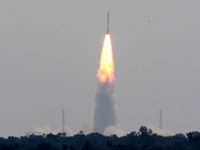Registration
You will receive an email confirming your registration.
IMGXYZ2980IMGZYXIndia’s civil space program is coming under increasing scrutiny. In March 2011, India successfully tested a ballistic missile defense system. Shortly after the test, V.K. Saraswat, scientific adviser to the defense minister and director general of the Defence Research and Development Organisation (DRDO), stated that the defense system proved India’s capability to effectively neutralize an adversary’s satellite. In the third installment of the Carnegie-Tsinghua Center for Global Policy series “China and South Asia’s Future,” Bharath Gopalaswamy, a scholar in the Judith Reppy Institute for Peace and Conflict Studies at Cornell University, offered an overview of how far the Indian space program has come and where it is headed. This event was moderated by Carnegie’s Lora Saalman.
Space as a Civil Domain
- Natural Disaster Monitoring: South Asia houses 22 percent of the global population. For South Asian countries, space research remains firmly rooted in agriculture and natural disaster preparation and monitoring, Gopalaswamy said. If countries in the region are willing to share the information they gather from satellites monitoring weather patterns, he suggested there could be a significant benefit to efforts to predict environmental disasters. One of the Chinese participants asked whether such satellites could also be employed to monitor China, particularly when it came to water disputes. Gopalaswamy replied that geographic surveying via remote sensing could include a wide variety of monitoring.
- From Import to Indigenization: The Indian Space Research Organisation (ISRO) has become the primary vehicle of India’s civil space program, Gopalaswamy explained. In recent years, ISRO has begun to focus on the procurement of information satellites from abroad. India has invested highly in domestic development of this technology and information satellites have come to densely populate the country’s existing satellite program. Similarly, India has transitioned away from early reliance on foreign launch services to become a launch service provider itself. In a program that has lasted four decades, India has seen more than 22 launch vehicle missions. India’s first lunar mission, the Chandrayaan-1, has served as one of its greatest indigenous achievement to date.
Space as a Military Domain
The concept of Aerospace Command remains at a level of academic debate within India, but Gopalaswamy noted that India has established a sector dedicated to space technology under the command of the Integrated Defence Services.
- Indian Navy and Air Force: While India currently lacks a dedicated military satellite, the Indian Air Force and the Indian Navy have both openly expressed their interest in possessing dedicated satellites to facilitate their communication- and network-centric warfare requirements, Gopalaswamy said. The launch of India’s naval satellite has been scheduled for 2011.
- Anti-satellite Weapons Capabilities: When asked by one of the Chinese participants about India’s ability to target and destroy satellites, Gopalaswamy replied that India’s anti-satellite weapons capability remained unproven. However, he added that Indian interest in the use of satellites for military and intelligence-gathering purposes should come as no surprise. Government officials in India feel their country possesses all of the building blocks needed to develop anti-satellite weapons and, indeed, already has the ability to take out satellites with its existing missile defense capabilities.
- Militarization versus Weaponization: While space is already militarized, there is a great deal of international ambiguity over what constitutes the weaponization of space, Gopalaswamy said. In response to a question posed by a Chinese attendee, Gopalaswamy explained that a number of countries can utilize their telecommunication and remote-sensing capabilities for military reconnaissance, just as the United States has done with its telecommunication satellites during both Iraq wars and the ongoing operations in Afghanistan. While not serving a dedicated military function, advances in its Cartosat-series of high-resolution satellites allow India to monitor its surroundings around-the-clock.
The Current Scenario
Satellites play a central role in a number of countries’ economic and military pursuits and space debris from the United States, Russia, and China already endangers other objects launched into space. Gopalaswamy offered some predictions on the evolution of India’s space program.
- Cooperation in Space: As part of efforts to enhance U.S.-India cooperation, initiated with the 2005 civil nuclear cooperation deal, there has been increased attention to shared interests in civil space development, Gopalaswamy said. In January 2011, the United States removed a number of Indian space research companies from a U.S. Department of Commerce list that requires businesses, research institutions, organizations, and individuals to fulfill specific license requirements. Saalman asked if such actions could be cause for concern for China, and Gopalaswamy argued that regional and international collaboration will guide the future of India’s space policy, which has been shaped by realism rather than as an effort to counterbalance China.
- Impact of Failure on Advances: One Chinese participant asked about the impact and implications of failures within India’s space program. Gopalaswamy stated that failure is a realistic and sometimes advantageous aspect of scientific inquiry, which can push research and collaboration in new directions.
- India’s Strengths vis-à-vis Others: One Chinese participant who had attended Sino-Indian government meetings on space issues asked if India was still generally considered to have more advanced launch and remote-sensing technology than China. Gopalaswamy stated that while India remains strong in these two arenas—which are crucial for disaster relief and monitoring—this technology does not necessarily have strategic roles or implications.
- Sino-Indian Scientist Cooperation: Gopalaswamy asserted that competitiveness between China and India over space technology should be mitigated; India is best served not by comparing itself with others but rather by its internal achievements. Enhanced scientist-to-scientist collaboration could be a valuable next step in preventing potentially counterproductive competition.
